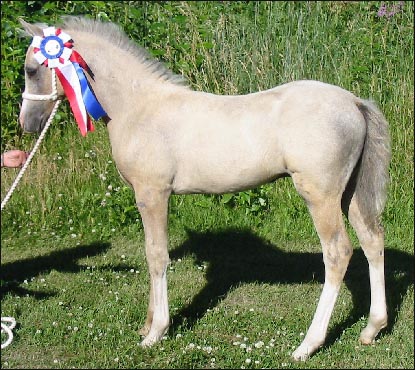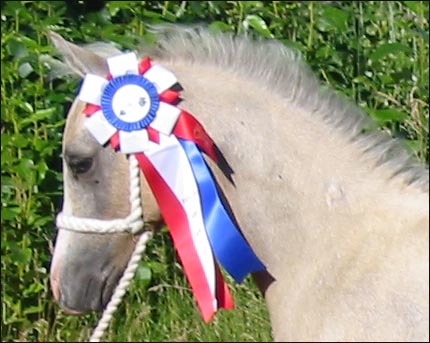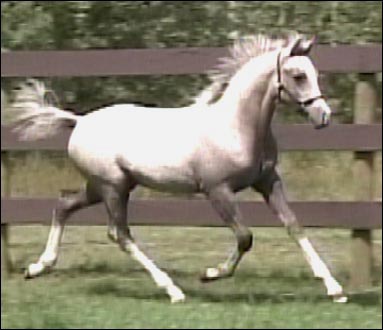I’ve actually just emailed a good friend in Germany [who has used both Dornik and Don’t Worry repeatedly] to try and get more info on whether she’s heard about the colour combinations I’ve been told about by other breeders, coming from this particular line. She knows our colt Dornik Folklore’s breeder very, very well, and our colt is actually agisted with her at the moment, too, so I’ve asked her if she can arrange for him to be DNA’d to confirm things that way. I want to point out, though, that, as someone else mentioned as well, before I spent a couple of decades away from the horse industry, it was commonly known that buckskins and duns were the same colour. I studied a lot and read many books and breed standards that said so, but now it’s common knowledge [as I found out from this thread only last night] that they’re not the same. And, regardless of what is the case with our colt [who, remember, was owned/bred by a reputable breeder, through natural service to Dornik, who as far as I know is owned by a VERY reputable breeder], we need to remember that it’s happened perhaps thousands of times in recent years alone that things we unquestionably believed to be the case are later found to be inacurate. So, I do think we should be more careful about saying what is and isn’t possible, the world is not so black and white, and we don’t know everything yet.
And, for what it’s worth, I was a successful breeder of palominos in the late 70’s/early 80’s, using my very liver chestnut stallion and my anglo-arab palomino mares. And, at the time I was seriously studied on all things colour-related with breeding them,but I was very careful not to come in on this thread yesterday touting what I knew to be the case, because I realize that what we believed was the case then can differ vastly from what has been proven since, ie what’s been explained about buckskin/duns. And, I think it’s naive to think that we won’t find out about more things [including horse-colour related things] in the future, as well. We also bred very good German Shepherds for many years, and one day we had a black and tan bitch throw a couple of red on tan pups. That bloodline continued to throw that colour occasionally, and when we started to breed with a bitch who was that colour herself, the colour became dominant. The Australian standard for shepherds, and many many breeders in Aus, told us that there must be outside blood to cause the colour, or else it was impossible. And, only many years later were we told about a very rare colour called mahogany in shepherds, and that that was what colour our dogs were. Now, I haven’t bred any shepherds for over a decade [though we still have two of our “mahogany” ones], and haven’t bred them commercially for more than two, so I don’t know of any recent advancements with them, either. I don’t keep up to date on it any more. But, I’m happy to accept that our shepherds are probably mahogany, because there was little to no chance of there being any other explanation. For those who know what I’m referring to, remember that despite many, many years of scientific evidence proving otherwise, Lindy Chaimberlain’s baby WAS killed by a dingo!
As far as I’ve been told, neither Dornik nor Don’t Worry have been tested for a dilute gene, and given some of the progeny I’ve seen and been told about, I’m happy to remain open to the possibility they carry one, at least until/unless it’s confirmed either way scientifically. I’m also happy to stay open to the other possibility that our colt is perhaps a very light bay, rather than a buckskin [as well as that our other colt [Deville] could be a dark buckskin or something else], and I’ll be curious and happy to confirm what the facts are once I have them, whatever they may be. Finally, the particular shade of chestnut I mentioned earlier [Alabastro and Allegria, and others I’ve seen], I believe personally that it will eventually be found to be different in some way genetically from typical chestnuts, because it’s not just lighter, it’s DIFFERENT. It’s okay to be open to the possibility that we may not know it all yet, because that keeps being proven to be the case in just about everything.:winkgrin: :winkgrin: :winkgrin:
Kelly.

 And the other question, is it worth then getting the mare and foal tested for the cream gene or am I way off?
And the other question, is it worth then getting the mare and foal tested for the cream gene or am I way off?


 - Grey is the same, it is dominant in the sense that it is always apparent when present, but not dominant to the base colour but rather is something that HAPPENS TO the base colour
- Grey is the same, it is dominant in the sense that it is always apparent when present, but not dominant to the base colour but rather is something that HAPPENS TO the base colour nitpick away (not offended or anything)…I was just trying to put it into layman’s terms. I still think my comparison to human hair graying works…start out a color, then color disappears. I never said the horse was no longer genotypically chestnut, palomino or whatever. I’m simply talking phenotype.
nitpick away (not offended or anything)…I was just trying to put it into layman’s terms. I still think my comparison to human hair graying works…start out a color, then color disappears. I never said the horse was no longer genotypically chestnut, palomino or whatever. I’m simply talking phenotype. ) as there are no Perlinos
) as there are no Perlinos